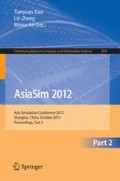Abstract
This paper presents a simulation of a biological more plausible neural network system. The system modeled a Spiking Neural Network for self-organized architecture. Recently, Spiking Neural Networks have been much considered in an attempt to achieve a more biologically realistic neural network which was coined as the third generation Artificial Neural Networks. Spiking neurons with delays to encode the information is suggested. Thus, each output node will produce a different timing which enables competitive learning. The suggested mechanism is designed and analyzed to perform self-organizing learning and preserve the inputs topology. The simulation results show that the model is feasible to perform a self-organized unsupervised learning. The mechanism is further assessed in real-world dataset for data clustering problem.
Access this chapter
Tax calculation will be finalised at checkout
Purchases are for personal use only
Preview
Unable to display preview. Download preview PDF.
References
Gerstner, W., Kistler, W.: Spiking Neuron Models. Cambridge Univ. Press (2002)
Kohonen, T.: Self-Organising Maps. Springer, Germany (2001)
Maass, W.: Computing with Spiking Neurons. In: Maass, W., Bishop, C.M. (eds.) Pulsed Neural Network, pp. 55–85. MIT Press (1998)
Panchev, C., Wermter, S.: Hebbian Spike-Timing Dependent Self-Organization in Pulsed Neural Networks. In: Proceedings of World Congress on Neuroinformatics (2001)
Ruf, B., Schmitt, M.: Self-organization of spiking neurons using action potential timing. IEEE Transactions on Neural Networks 9(3), 575–578 (1998)
Sala, D.M., Cios, K.J.: Self-organization in networks of spiking neurons. Australian Journal of Intelligent Information Processing Systems 5(3), 161–170 (1998)
UCI repository of machine learning databases, http://archive.ics.uci.edu/ml
Author information
Authors and Affiliations
Editor information
Editors and Affiliations
Rights and permissions
Copyright information
© 2012 Springer-Verlag Berlin Heidelberg
About this paper
Cite this paper
Bidin, J., Amin, M.K.M. (2012). Towards a Biological More Plausible Artificial Neural Networks. In: Xiao, T., Zhang, L., Fei, M. (eds) AsiaSim 2012. AsiaSim 2012. Communications in Computer and Information Science, vol 324. Springer, Berlin, Heidelberg. https://doi.org/10.1007/978-3-642-34390-2_20
Download citation
DOI: https://doi.org/10.1007/978-3-642-34390-2_20
Publisher Name: Springer, Berlin, Heidelberg
Print ISBN: 978-3-642-34389-6
Online ISBN: 978-3-642-34390-2
eBook Packages: Computer ScienceComputer Science (R0)

